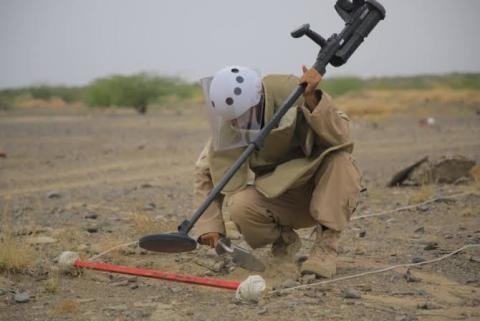Covid-19 deepens the crisis in war-torn Yemen


A coronavirus catastrophe is unfolding in Yemen, which has been ravaged by civil war since 2015. The Covid-19 pandemic has now exacerbated the situation for millions of people in the famine-stricken nation, where the healthcare system has, in effect, collapsed.
One of the Arab world’s most impoverished nations, Yemen is located on the southern tip of the Arabian Peninsula, and has been beleaguered by civil war between the Saudi-backed government based in Aden, and its rivals in the north, the Houthis, who are aligned with Iran. Thousands of civilians have been killed and tens of thousands injured as a result of hundreds of airstrikes launched by the Saudi- and Emirati-led coalition that has been attempting to regain control of areas taken by Houthi rebels.
As per the aid agency International Rescue Committee (IRC), the relentless airstrikes by the coalition forces have arbitrarily hit residential homes and public areas such as schools, health facilities and markets, leaving a trail of destruction that has cut off people’s access to food, medicine and clean water. Hunger, malnutrition and diseases like cholera have been prevalent across the country, making it one of the world’s most severe ongoing humanitarian disasters. An estimated 80% of Yemen’s population is said to be in need of emergency relief and assistance.
Following the Covid-19 outbreak, the healthcare crisis is projected to get worse, with aid agencies warning of another calamity looming over the existing one, which may escalate deaths. The IRC noted that in many crisis-affected countries such as Yemen, for which Covid-19 data is either incomplete, inconsistent or absent entirely, tracking the spread of the virus, particularly among the most vulnerable, is all the more difficult.
On May 22 2020, the United Nation warned that the situation in Yemen is “extremely alarming” and the country is “on the brink” of a humanitarian disaster. “Aid agencies in Yemen are operating on the basis that community transmission is taking place across the country,” spokesperson for the UN Office for the Coordination of Humanitarian Affairs Jens Laerke noted.
On April 10, Yemen’s first case of Covid-19 was confirmed in Hadhramaut, sparking panic among its conflict-battered population. The virus-related cases have now been reported in 10 governorates: Aden, Hadramaut, Taizz, Lahj, Abyan, Al Maharah, Shabwah, Marib, Al Dhale’e and Sana’a City. Yemen has reported 184 cases and 30 fatalities, but “the actual incidence is almost certainly much higher,” Laerke said, adding: “They are talking about having to turn people away because they do not have enough [medical] oxygen, they do not have enough personal protective equipment.”
Sick at home
In the country’s interim capital, Aden, international aid group Doctors Without Borders, or Medecins Sans Frontieres (MSF), noted that the virus-related death toll at a medical centre it runs in southern Yemen confirms “a wider catastrophe unfolding” in the country. MSF’s facility in Aden admitted 173 patients between April 30 and May 17, at least 68 of whom have died. Many patients that arrived at the centre, MSF stated, were already suffering from acute respiratory distress syndrome, making it hard to save their lives and suggesting that many more people are sick at home.
“What we are seeing in our treatment centre is just the tip of the iceberg in terms of the number of people infected and dying in the city,” MSF’s operations manager for Yemen, Caroline Seguin, said in a statement. “People are coming to us too late to save, and we know that many more people are not coming at all: they are just dying at home.”
Yemen’s UN-recognised government based in the south has confirmed 197 cases nationwide, with 33 fatalities. The tally, however, does not include confirmed cases in the country’s north, which is under the control of Houthi rebels who are accused of concealing the magnitude of the coronavirus outbreak by suppressing numbers and intimidating journalists and doctors. Contrary to low government estimates, UK-based humanitarian organisation Save the Children operating from Aden earlier also noted that at least 385 people in the port city had died of coronavirus-like symptoms.
An estimated nine million people receive health services at 189 hospitals and 200 primary healthcare centres across Yemen. But new data published by the IRC reveals Yemen has one of the lowest testing numbers, even compared with other conflict-affected countries, at 31 tests per million. The country has around 500 ventilators and 700 intensive care unit beds. There are 100 oxygen cylinders per month for every 2.5 million people.

Yemeni officials on Monday condemned arrests and prosecutions by the Iran-backed Houthi militia directed against media, journalists and celebrities…

Yemen's warring parties are gearing up for new waves of conflict in 2023 amid a lack of decisive steps towards sustainable peace, adding to the suf…

The UAE will help to recruit doctors and deliver crucial supplies for hospitals in Yemen under a major healthcare drive. The Khalifa bin…